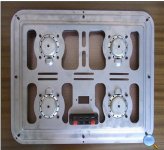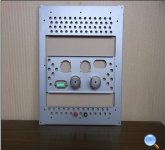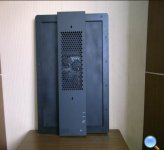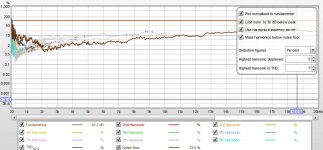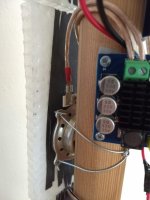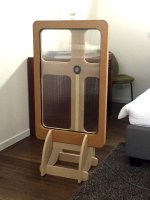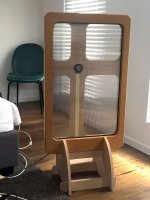Plus I plan to be trying different exciters, different panels (maybe making or modifying my own fiberglass or CF foam core panels), moving exciters around, stiffening edges, damping edges, clamping edges, adding masses, modeling modes shapes and playing with every version I can think of until my wife says I have to stop!
Patents aren't necessarily helpful. It might be a patent for a panel intended for use in live sound reinforcement or an airport PA system. You'd want to find patents intended for home use. On the other hand, if you read Earl Geddes' books and papers on low frequency behavior in rooms it will help your DML design.
Most DML DIYers are designing for home room listening. Consequently, the root of all DIYer DML problems is attempting to design bass into the mains when it isn't needed or helpful. The second problem DML DIYers run into is boundaries and speaker placement. Panel dampening and actuator placement is tertiary, at that point you're optimizing.
DMLBES,
Probably you are getting tired of me making you repeat yourself. Please understand that I very much appreciate and respect your input. Thank you. Please don't think otherwise!
Got it. I will definitely try the frame/spline version.
And that was actually the reason I posted it. I was sharing a source that seemed consistent with your strategy.
Fair question. Notwithstanding your good arguments for the frame/spline, and that patents that appear to support the frame/spline, there seem to be a lot of people that are very happy with their own results without using a frame/spline (yes, I admit including the Tech ingredients videos). Another is the Parts Express DML Flat Panel project. And on top of that, as far as I can tell, the exciters I'm seeing (at least on the Parts Express catalog) don't really appear to be made with a means of attaching them to the spline. Some of them have do have 3 or 4 arms extending out, and if I'm not mistaken you (or someone else maybe) said those were for attaching to a support (i.e. frame/spline) and not the panel. But the more I looked at them and what Parts Express seems to be showing, it looks more like they intend those as extra points to attach to the panel. (If I'm wrong about this please show me an exciter that is clearly meant to be mounted to a frame!)
So, while your arguments for the frame/spline approach make very good sense to me, there's all this other evidence that many people, including the people selling the exciters, don't seem to think the frame/spline is needed. So I'm left wondering how to square this in my mind. Are people simply unaware of the benefits of the frame/spline? Or did they try it and find the difference wasn't significant? Or have the exciters changed some way since the patents were written, and hence somehow made the frame/spline less important?
In any event, I plan to try both approaches (you've convinced me that the frame/spline is worth trying). Plus I plan to be trying different exciters, different panels (maybe making or modifying my own fiberglass or CF foam core panels), moving exciters around, stiffening edges, damping edges, clamping edges, adding masses, modeling modes shapes and playing with every version I can think of until my wife says I have to stop!
Thanks,
Eric
People can be happy with there results of not using a frame or spline. I never said otherwise. I am assuming you are talking about Rich M's P.E. DML project? Rich's design is a "beginner", intro into DML's. He does not use a frame nor a spline but he does not use strings either as his panels are suspended by stands with damping. I am curious as to what made Tech Ingredients hang his panels by strings even though he got the concept from Rich's design in which he mentions in his video since Rich's design does NOT use strings suspended from the ceiling.
Dayton just makes (PARTS) exciters...They DONT make (splines/brace) "DESIGNS", for the exciters as that is up to the DIYer.
No, you are mistaken as you are confusing the legs on a exciter to the mounting holes on certain exciters as they are two totally different things. Legs on the exciter act as extra support while the mounting holes are meant to mount the exciter to a brace or spline the same way one would mount a conventional cone speakers basket to a wood box. Mounting holes on certain (heavy robust) exciters prove that certain exciters are meant to be used and mounted on a spline/brace because they are using larger magnets and in return will have greater voice coil sag. Larger more heavier the magnet on a exciter will result in greater sag. Voice coil sag causes a lot of distortion as well as unevenness of the modal modes.
What other evidence? All the evidence points to and supports the use of a frame and a spline/brace both by DIY enthusiast and Commercialized DML manufacturers. Ive yet to HEAR the explanation/reasoning of the advantages of hanging a panel by a string. Exciters haven't changed much since NXT made them popular in the 90's.
Now you are speaking my language as its all about HANDS on EXPERIENCE and trying out all different types of ways and methods. What ever way sounds best to you is the way you should go. Good luck with your journey.
Billionsound makes the actuators for Dayton. If you look at Billinsound's web site you'll see they don't use a spline on their subwoofer. They use six of the RMB002511H13-BS exciters with sticky feet.
Subwoofer: http://www.billionsound.com/products_detail/productId=379.html
11H13 Exciter: http://www.billionsound.com/products_detail/productId=269.html
Their flat wall speaker RMF130913D16 uses a design with a spline.
Flat wall: http://www.billionsound.com/products_detail/productId=359.html
Exciter 12K09 (Dayton DAEX25FHE-4): 睿门企业有限公司
And this is how they use the 12K02 (Dayton DAEX25SHF-4)
http://www.billionsound.com/products_detail/productId=360.html
Here's their ceiling speaker with two 11L24 (DAEX25TP-4 Tripod Feet)
http://www.billionsound.com/products_detail/productId=453.html
Subwoofer: http://www.billionsound.com/products_detail/productId=379.html
11H13 Exciter: http://www.billionsound.com/products_detail/productId=269.html
Their flat wall speaker RMF130913D16 uses a design with a spline.
Flat wall: http://www.billionsound.com/products_detail/productId=359.html
Exciter 12K09 (Dayton DAEX25FHE-4): 睿门企业有限公司
And this is how they use the 12K02 (Dayton DAEX25SHF-4)
http://www.billionsound.com/products_detail/productId=360.html
Here's their ceiling speaker with two 11L24 (DAEX25TP-4 Tripod Feet)
http://www.billionsound.com/products_detail/productId=453.html
Attachments
If you have a question about how to use a Dayton exciter you can usually figure it out by checking Billionsound's web site.
Again, remember that you're probably designing for a small room and don't need bass in your mains. Humans can't hear stereo below ~75Hz so you're certainly all mono below that range. Your room modes destroy stereo up to the transition frequency so you might as well go mono in that range too.
DMLs provide the most benefits above the room transition frequency. In small rooms, they perform like all other speakers below the transition frequency (bass frequencies.) In the case of bass frequencies, the decision to go with DML is based on cosmetic preference.
Again, remember that you're probably designing for a small room and don't need bass in your mains. Humans can't hear stereo below ~75Hz so you're certainly all mono below that range. Your room modes destroy stereo up to the transition frequency so you might as well go mono in that range too.
DMLs provide the most benefits above the room transition frequency. In small rooms, they perform like all other speakers below the transition frequency (bass frequencies.) In the case of bass frequencies, the decision to go with DML is based on cosmetic preference.
Last edited:
Billionsound makes the actuators for Dayton. If you look at Billinsound's web site you'll see they don't use a spline on their subwoofer. They use six of the RMB002511H13-BS exciters with sticky feet.....
Bradleypnw,
Thanks for the images and the links to the Billionsound site. I had looked there before myself but had so much difficulty navigating the site that I gave up before I found anything useful. Can you tell from the website or do you have any idea from other sources what they are using for panels?
Also thanks for the link to the Dayton Audio Exciter page. I had not seen that before and it's interesting to see their recommendations for exciter placement and suspension.
And can you explain again how important it is to have base in your mains (Haha...kidding!)
Kidding aside, and your point is well taken, I do wish I understood better what actually determines the low end. It's pretty easy to model conventional cabinet/driver design (i.e Bass reflex, TL etc) and know how low it'll go, but I haven't seen anything comparable for a DML.
Eric
The fun begins...
My Dayton DAEX32U-4 Ultra 32mm 20W 4 Ohm exciters arrived yesterday. I ordered four, with the tentative idea being to use two in each panel, wired to give 8 ohms resistance since my amp is designed for 8 ohms. I also ordered 4 of the cheaper DAEX25FHE-4, just to see if there was really much difference, but those are still on back order.
So, obviously I had to start playing around. I wired up just a single exciter and pressed it up against a bunch of different "panels". So far, I have not actually bought any materials to use for panels, but I have a bunch of stuff in the workshop to play with. The materials I tried included XPS (foamular 250), plywood (various sizes, types, thickness), aluminum sheet (about .030" thick) and foamcore, and corrugated cardboard. Most of the panels I tried were in the neighborhood of 2'x4', though I also tried smaller plywood and XPS panels too.
Without proper suspension for the panels and not wanting to actually attach the exciters to anything just yet, I had to figure out how to hold both the panel and exciter against each other without interfering too much with the interaction. What I settled on was placing one long edge of the panel on a foam covered seat, tilting it back slightly and letting the panel's weight push against the exciter (which I held in my hand). This worked pretty well for the heavier panels like plywood. For the lighter panels, I had to create a little more force to keep the panel and exciter in good contact. Initially I pushed against the face of the panel, opposite the exciter. But later I found that pulling gently toward the exciter on the top edge of the panel worked better.
With each of the panels I tried playing pink noise, doing a sine sweep, and playing actual music.
My intention was to look real time SPL spectrums while playing the pink noise, but unfortunately my "lab" (i.e. basement) is too noisy due to the HVAC system, so I gave up on the pink noise.
Here are my observations:
First I was really surprised about how similar the various materials sounded. Yes, there were big differences, but not nearly as big as I expected. Especially when playing the sine sweeps, and most especially above about 500 Hz. For virtually every panel, somewhere in the neighborhood of 500-1000 Hz, I stopped sensing the vibration of the exciter in my hand, but the sound really got loud and clear. And it was very difficult to tell where the sound was actually coming from! It was a strange feeling. All of them gave what seemed to me to be decent output up to about 11 Khz, where I stop hearing.
I was also surprised at how little difference the exciter location seems to matter. Sure, it mattered, but not like I expected. I've done a lot of experimenting with windchimes, and I know that striking a windchime at even slightly different locations can dramatically change its response. I thought the panels might be similarly affected. Rather, it seemed to make very little difference in the case of the panels. Yes, as the exciter got close to the edge, the output fell. But otherwise, it seemed like if the exciter was anywhere near, say, the middle third of the panel, it pretty much sound the same no matter where it was. I suspect the reason for the difference (between panels and winchimes) is because windchimes have far fewer natural frequencies and are virtually undamped, compared to panels.
I was also surprised at how little it mattered how I actually supported the panels. No matter whether I held on to the of edge of the panel near the center, or near the corner, or just let the panel rest against the exciter with no hand on top at all, the sound was pretty much the same.
Under these conditions, the panel whose sound I most preferred was plywood (0.2" thick "Sureply" underlayment). Thicker plywood was too quiet. Foamcore was my next favorite, and was louder than the plywood. The XPS was certainly loudest, but it sounded too much like it was coming from a tunnel. The aluminum wasn't as terrible as I expected, but did have some annoying ringing.
Next, I'm kind of eager to select a panel material and make a crude pair, just to see how they sound in stereo. I'm tempted to just try a pair of the plywood ones, but I may try some other panels first. Gatorboard seems really interesting, so I may try some of that first.
Any and all comments and suggestions would be appreciated!
Oh, and yes, DMLBES, the Ultra exciters indeed have a threaded hole in the center back, which I must assume is for mounting to a spline. Curiously the specs don't mention it and the drawing don't tell you what the thread is!
Eric
My Dayton DAEX32U-4 Ultra 32mm 20W 4 Ohm exciters arrived yesterday. I ordered four, with the tentative idea being to use two in each panel, wired to give 8 ohms resistance since my amp is designed for 8 ohms. I also ordered 4 of the cheaper DAEX25FHE-4, just to see if there was really much difference, but those are still on back order.
So, obviously I had to start playing around. I wired up just a single exciter and pressed it up against a bunch of different "panels". So far, I have not actually bought any materials to use for panels, but I have a bunch of stuff in the workshop to play with. The materials I tried included XPS (foamular 250), plywood (various sizes, types, thickness), aluminum sheet (about .030" thick) and foamcore, and corrugated cardboard. Most of the panels I tried were in the neighborhood of 2'x4', though I also tried smaller plywood and XPS panels too.
Without proper suspension for the panels and not wanting to actually attach the exciters to anything just yet, I had to figure out how to hold both the panel and exciter against each other without interfering too much with the interaction. What I settled on was placing one long edge of the panel on a foam covered seat, tilting it back slightly and letting the panel's weight push against the exciter (which I held in my hand). This worked pretty well for the heavier panels like plywood. For the lighter panels, I had to create a little more force to keep the panel and exciter in good contact. Initially I pushed against the face of the panel, opposite the exciter. But later I found that pulling gently toward the exciter on the top edge of the panel worked better.
With each of the panels I tried playing pink noise, doing a sine sweep, and playing actual music.
My intention was to look real time SPL spectrums while playing the pink noise, but unfortunately my "lab" (i.e. basement) is too noisy due to the HVAC system, so I gave up on the pink noise.
Here are my observations:
First I was really surprised about how similar the various materials sounded. Yes, there were big differences, but not nearly as big as I expected. Especially when playing the sine sweeps, and most especially above about 500 Hz. For virtually every panel, somewhere in the neighborhood of 500-1000 Hz, I stopped sensing the vibration of the exciter in my hand, but the sound really got loud and clear. And it was very difficult to tell where the sound was actually coming from! It was a strange feeling. All of them gave what seemed to me to be decent output up to about 11 Khz, where I stop hearing.
I was also surprised at how little difference the exciter location seems to matter. Sure, it mattered, but not like I expected. I've done a lot of experimenting with windchimes, and I know that striking a windchime at even slightly different locations can dramatically change its response. I thought the panels might be similarly affected. Rather, it seemed to make very little difference in the case of the panels. Yes, as the exciter got close to the edge, the output fell. But otherwise, it seemed like if the exciter was anywhere near, say, the middle third of the panel, it pretty much sound the same no matter where it was. I suspect the reason for the difference (between panels and winchimes) is because windchimes have far fewer natural frequencies and are virtually undamped, compared to panels.
I was also surprised at how little it mattered how I actually supported the panels. No matter whether I held on to the of edge of the panel near the center, or near the corner, or just let the panel rest against the exciter with no hand on top at all, the sound was pretty much the same.
Under these conditions, the panel whose sound I most preferred was plywood (0.2" thick "Sureply" underlayment). Thicker plywood was too quiet. Foamcore was my next favorite, and was louder than the plywood. The XPS was certainly loudest, but it sounded too much like it was coming from a tunnel. The aluminum wasn't as terrible as I expected, but did have some annoying ringing.
Next, I'm kind of eager to select a panel material and make a crude pair, just to see how they sound in stereo. I'm tempted to just try a pair of the plywood ones, but I may try some other panels first. Gatorboard seems really interesting, so I may try some of that first.
Any and all comments and suggestions would be appreciated!
Oh, and yes, DMLBES, the Ultra exciters indeed have a threaded hole in the center back, which I must assume is for mounting to a spline. Curiously the specs don't mention it and the drawing don't tell you what the thread is!
Eric
Last edited:
And can you explain again how important it is to have base in your mains
Bass in mains is about as important as a carbon fiber racing spoiler on the back of a Buick minivan packed with kids on their way to soccer practice driving up a steep hill to the pitch.
Billionsound uses different types of panel materials. Some are honeycomb core resin infused paper. Others are corrugated plastic sign board material. Two part resins will give you a hard surface. Glue gives a less hard surface. Panel material and treatment is relevant to the type of dampening you're trying to achieve so the right choice always depends on what you're trying to accomplish. I wanted a lot of internal dampening in my panels so I placed resin on only one side of a cloth covered poly-honeycomb core. But there's no right or best material for all panel designs. Just as you have flexibility in frames vs splines vs panel suspensions, you have flexibility in panel materials.
Last edited:
Distortion seems to be a common issue with DML speakers. And while I have not measured distortion for any of my panels yet, I'm pretty sure all my attempts have pretty high distortion, including panels of plywood, XPS and foamcore.
I just came across this patent application below, which claims much reduced distortion for panels made with aramid polyamide skins (Kevlar, etc), rather than carbon fiber, purportedly due it's higher damping qualities.
Anybody tried (DIY or commercial) panels with Kevlar or similar skins?
Eric
US20030081799A1
United States
The core is sandwiched between facing skins made of a material with a high Young's modulus, a high tan delta, a high tensile strength, and low self noise. Preferably, this material is an aramid polyamide such as Kevlar®, Nomex®, Conex®, or Technora®, all of which exhibit these properties. The facing skins are fixed to the core with an adhesive that is flexible and has high acoustic damping qualities and high shock resistance, such as rubber cements, silicone adhesives, and water-based acrylic adhesives. The result of the combination of these materials with their respective properties is a flat panel sound radiator that exhibits signal-to-noise greater than 40 dB for an 85 dB input signal within key audio frequency ranges, which is 20 dB or more greater than prior art flat panel sound radiators.
I just came across this patent application below, which claims much reduced distortion for panels made with aramid polyamide skins (Kevlar, etc), rather than carbon fiber, purportedly due it's higher damping qualities.
Anybody tried (DIY or commercial) panels with Kevlar or similar skins?
Eric
US20030081799A1
United States
The core is sandwiched between facing skins made of a material with a high Young's modulus, a high tan delta, a high tensile strength, and low self noise. Preferably, this material is an aramid polyamide such as Kevlar®, Nomex®, Conex®, or Technora®, all of which exhibit these properties. The facing skins are fixed to the core with an adhesive that is flexible and has high acoustic damping qualities and high shock resistance, such as rubber cements, silicone adhesives, and water-based acrylic adhesives. The result of the combination of these materials with their respective properties is a flat panel sound radiator that exhibits signal-to-noise greater than 40 dB for an 85 dB input signal within key audio frequency ranges, which is 20 dB or more greater than prior art flat panel sound radiators.
I'm pretty sure the Podium speakers used a Kevlar faced honeycomb material.
This review says the Podium skins were Mylar (PET). Maybe it was a different panel you are thinking of? I sure don't know. However the review agrees that the core is honeycomb (phenolic).
I recall reading that Katz wanted the panels to ring. Which is the opposite of what the cited patent application is saying is ideal.
Podium Sound 0.5 Loudspeakers The limitations may very well be your own room. Review By Ron Nagle
Katz wasn't actually the brains... He was the marketing machine in front. Podium technology is now owned by a French guy but the business is inactive.
Just noticed that Mouser has a number of exciters. Here's a low frequency one...
ASX08604-SW-R PUI Audio | Mouser New Zealand
ASX08604-SW-R PUI Audio | Mouser New Zealand
XRK971 posted a lot of plots including THD plots on the very first post of this thread which are worth reviewing.
A Study of DML's as a Full Range Speaker
A Study of DML's as a Full Range Speaker
Distortion seems to be a common issue with DML speakers. And while I have not measured distortion for any of my panels yet, I'm pretty sure all my attempts have pretty high distortion, including panels of plywood, XPS and foamcore.
I just came across this patent application below, which claims much reduced distortion for panels made with aramid polyamide skins (Kevlar, etc), rather than carbon fiber, purportedly due it's higher damping qualities.
Anybody tried (DIY or commercial) panels with Kevlar or similar skins?
Eric
US20030081799A1
United States
The core is sandwiched between facing skins made of a material with a high Young's modulus, a high tan delta, a high tensile strength, and low self noise. Preferably, this material is an aramid polyamide such as Kevlar®, Nomex®, Conex®, or Technora®, all of which exhibit these properties. The facing skins are fixed to the core with an adhesive that is flexible and has high acoustic damping qualities and high shock resistance, such as rubber cements, silicone adhesives, and water-based acrylic adhesives. The result of the combination of these materials with their respective properties is a flat panel sound radiator that exhibits signal-to-noise greater than 40 dB for an 85 dB input signal within key audio frequency ranges, which is 20 dB or more greater than prior art flat panel sound radiators.
To reduce resonance/distortion use "DAMPING".
My method as mentioned before is using some sort of damping material like Frost King weather strip foam to adhere the panel to the frame all around the edges of the panel. This method reduces resonance/distortion the SAME WAY a conventional cone type of speaker uses a foam, rubber, and cloth surround on the "EDGES", of there diaphragm material using some type of adhesive (PVA water based glue adhesive) to attach the diaphragm material to the (frame) basket.
Again like a BMR driver but on a way larger scale.
Anyone into BMR technology should look into DML's as you can make your own BMR. I've tried BMR's they sound good but they are what they are which is tiny. Compare it to a 2ft. DML panel and the BMR's sound tiny as most BMR's don't go over 3.5inchs. One can even combine the two designs and use a BMR as the high frequency driver and the DML as the mid to lows driver using a 2 way 1st or second order crossover. Using a BMR as a tweeter you can cross it over as low as 100hz, while most conventional tweeters wont go below 2k.
Like I said before the designs and combinations are endless. You can even combine DML/BMR tech with conventional cone tech. Dr.Shelly Katz wrote an article about in called "LAYERED SOUND". Even the super high end Goebel Bending wave loudspeaker uses layered sound combing it with conventional cone drivers. Here is Katz article> LAYEREDSOUND
Last edited:
DML = vibration
BMR = vibration + pistonic movement like a traditional cone speaker
Traditional cone speakers use stiff materials such as aluminum to reduce distortion. However, stiff materials can lead to bell ringing (resonance.) Ringing can be mitigated with damping. In addition, you can get distortion from the speaker motor when you play them too loud.
Layered Sound and Bending Wave is marketing language that can cause confusion. Distributed mode (modal behavior) is physics language that can cause confusion. We're just vibrating a surface to make sound in a DML speaker (Bending Wave.) If you add pistonic movement to the DML panel you have a BMR (Layered Sound.)
You can add pistonic movement to a DML panel via weight reduction and suspension design. If you use only one actuator to create a BMR you wind up with a small panel. Typically, one actuator is powerful enough to vibrate a large surface but not powerful enough to move a large surface in pistonic motion.
Paul Burton designed the first incarnation of the Shelly Katz Podium speakers.
Podium Sound planars
Paul designed a single DML panel powered by a vertical tapered line array of five exciters. He reduced the power of the actuators as they went up. Don Keele calls that "shading." Don Keele added time delay to shading as you travel up the vertical array to create his CBT array. Except Don Keele used traditional cone speakers rather than DMLs.
OK, so...1) use a stiff material/composite to reduce distortion, 2) use internal and/or edge damping to reduce ringing, and 3) use multiple exciters to reduce motor distortion at higher listening volumes.
If you want to add BMR pistonic movement reduce the weight of the panel and suspend it so it can move. If you want the BMR to have a louder listening volume add more BMRs in the form of an array.
If you choose the go the array route you have the option of following Paul Burton's and Don Keele's examples: power shading + time delay as you travel up the vertical array. If you have hard floors Don Keele's ground plane CBT design is probably the best way to go. Or if you plan to hang them on a hard surface ceiling.
If you combine DML + BMR + array you get a speaker that looks something like, but not necessarily like, the attached photos. A spline helps the exciters push the panel in pistonic motion. A smaller panel/weight helps the exciters push the panel in pistonic motion. Internal damping absent edge damping helps the exciters push the panel in pistonic motion. At the same time, the exciters are vibrating the panel surface as the surface moves in pistonic motion.
Finally, you can and should use different speakers below your room transition frequency. Bass frequencies can be separate DMLs or cone speakers, doesn't matter. I don't know if any companies are using silly Audiophile language to sell a combination of DMLs and traditional cone speakers but I hope not. I also don't know if it's a good idea to combine cone speakers with DMLs in the mid-high frequencies. Maybe that would be good in some way.
BMR = vibration + pistonic movement like a traditional cone speaker
Traditional cone speakers use stiff materials such as aluminum to reduce distortion. However, stiff materials can lead to bell ringing (resonance.) Ringing can be mitigated with damping. In addition, you can get distortion from the speaker motor when you play them too loud.
Layered Sound and Bending Wave is marketing language that can cause confusion. Distributed mode (modal behavior) is physics language that can cause confusion. We're just vibrating a surface to make sound in a DML speaker (Bending Wave.) If you add pistonic movement to the DML panel you have a BMR (Layered Sound.)
You can add pistonic movement to a DML panel via weight reduction and suspension design. If you use only one actuator to create a BMR you wind up with a small panel. Typically, one actuator is powerful enough to vibrate a large surface but not powerful enough to move a large surface in pistonic motion.
Paul Burton designed the first incarnation of the Shelly Katz Podium speakers.
Podium Sound planars
Paul designed a single DML panel powered by a vertical tapered line array of five exciters. He reduced the power of the actuators as they went up. Don Keele calls that "shading." Don Keele added time delay to shading as you travel up the vertical array to create his CBT array. Except Don Keele used traditional cone speakers rather than DMLs.
OK, so...1) use a stiff material/composite to reduce distortion, 2) use internal and/or edge damping to reduce ringing, and 3) use multiple exciters to reduce motor distortion at higher listening volumes.
If you want to add BMR pistonic movement reduce the weight of the panel and suspend it so it can move. If you want the BMR to have a louder listening volume add more BMRs in the form of an array.
If you choose the go the array route you have the option of following Paul Burton's and Don Keele's examples: power shading + time delay as you travel up the vertical array. If you have hard floors Don Keele's ground plane CBT design is probably the best way to go. Or if you plan to hang them on a hard surface ceiling.
If you combine DML + BMR + array you get a speaker that looks something like, but not necessarily like, the attached photos. A spline helps the exciters push the panel in pistonic motion. A smaller panel/weight helps the exciters push the panel in pistonic motion. Internal damping absent edge damping helps the exciters push the panel in pistonic motion. At the same time, the exciters are vibrating the panel surface as the surface moves in pistonic motion.
Finally, you can and should use different speakers below your room transition frequency. Bass frequencies can be separate DMLs or cone speakers, doesn't matter. I don't know if any companies are using silly Audiophile language to sell a combination of DMLs and traditional cone speakers but I hope not. I also don't know if it's a good idea to combine cone speakers with DMLs in the mid-high frequencies. Maybe that would be good in some way.
Attachments
DML = vibration
BMR = vibration + pistonic movement like a traditional cone speaker
Traditional cone speakers use stiff materials such as aluminum to reduce distortion. However, stiff materials can lead to bell ringing (resonance.) Ringing can be mitigated with damping. In addition, you can get distortion from the speaker motor when you play them too loud.
Layered Sound and Bending Wave is marketing language that can cause confusion. Distributed mode (modal behavior) is physics language that can cause confusion. We're just vibrating a surface to make sound in a DML speaker (Bending Wave.) If you add pistonic movement to the DML panel you have a BMR (Layered Sound.)
You can add pistonic movement to a DML panel via weight reduction and suspension design. If you use only one actuator to create a BMR you wind up with a small panel. Typically, one actuator is powerful enough to vibrate a large surface but not powerful enough to move a large surface in pistonic motion.
Paul Burton designed the first incarnation of the Shelly Katz Podium speakers.
Podium Sound planars
Paul designed a single DML panel powered by a vertical tapered line array of five exciters. He reduced the power of the actuators as they went up. Don Keele calls that "shading." Don Keele added time delay to shading as you travel up the vertical array to create his CBT array. Except Don Keele used traditional cone speakers rather than DMLs.
OK, so...1) use a stiff material/composite to reduce distortion, 2) use internal and/or edge damping to reduce ringing, and 3) use multiple exciters to reduce motor distortion at higher listening volumes.
If you want to add BMR pistonic movement reduce the weight of the panel and suspend it so it can move. If you want the BMR to have a louder listening volume add more BMRs in the form of an array.
If you choose the go the array route you have the option of following Paul Burton's and Don Keele's examples: power shading + time delay as you travel up the vertical array. If you have hard floors Don Keele's ground plane CBT design is probably the best way to go. Or if you plan to hang them on a hard surface ceiling.
If you combine DML + BMR + array you get a speaker that looks something like, but not necessarily like, the attached photos. A spline helps the exciters push the panel in pistonic motion. A smaller panel/weight helps the exciters push the panel in pistonic motion. Internal damping absent edge damping helps the exciters push the panel in pistonic motion. At the same time, the exciters are vibrating the panel surface as the surface moves in pistonic motion.
Finally, you can and should use different speakers below your room transition frequency. Bass frequencies can be separate DMLs or cone speakers, doesn't matter. I don't know if any companies are using silly Audiophile language to sell a combination of DMLs and traditional cone speakers but I hope not. I also don't know if it's a good idea to combine cone speakers with DMLs in the mid-high frequencies. Maybe that would be good in some way.
You cant make a exciter become pistonic by reducing the weight of the panel. The exciter has to already have the pistonic capabilities to begin with. Like I said before certain exciters have higher excursion then others.
These are working well for me.
I gather there is a lot of (audio) science working here that I don't fully understand as yet, and probably never will. I have tried to follow the Golden Ratio with the design, but I am not sure if it adds anything or not as these are the only DML's I've heard. You can change the frequency responce by adding blobs of bluetack around the diaphram and I am still experimenting with this, and other things.
At the moment they are in the guest bedroom to give some space between the speakers and rear wall. In my usual listening room, due to WAF, they had to be placed too close to the rear wall to work their 'magic'. I am not sure if the bed between them is adding or subtracting anything from their performance. I gather it is damping the sound though. Will try in another location soon.
How do they sound? I think their characteristics are summed up, better or as well as I could, in these two reviews, which might already be referenced here.
6moons audio reviews: Podium Sound Model 0.5
6moons audio reviews: Podium Sound Model 1
I gather there is a lot of (audio) science working here that I don't fully understand as yet, and probably never will. I have tried to follow the Golden Ratio with the design, but I am not sure if it adds anything or not as these are the only DML's I've heard. You can change the frequency responce by adding blobs of bluetack around the diaphram and I am still experimenting with this, and other things.
At the moment they are in the guest bedroom to give some space between the speakers and rear wall. In my usual listening room, due to WAF, they had to be placed too close to the rear wall to work their 'magic'. I am not sure if the bed between them is adding or subtracting anything from their performance. I gather it is damping the sound though. Will try in another location soon.
How do they sound? I think their characteristics are summed up, better or as well as I could, in these two reviews, which might already be referenced here.
6moons audio reviews: Podium Sound Model 0.5
6moons audio reviews: Podium Sound Model 1
Attachments
- Home
- Loudspeakers
- Full Range
- A Study of DMLs as a Full Range Speaker
